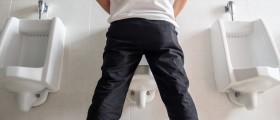
Hydronephrosis is a distension and dilation of the renal pelvis calyces. It is an enlargement, a ballooning effect, and widening of the funnel-like dilated proximal part of the ureter in the kidney. The resulting effect of this swelling of the kidney a progressive atrophy of this organ, that occurs when the urine flow is blocked and results in a back pressure in the urinary system. Hydronephrosis actually translates as “water on the kidney”. Hydronephrosis may affect both kidneys, or just one at the time. The signs and symptoms typically vary depending on the nature of the condition.
Signs and symptoms of hydronephrosis
The signs and symptoms of this condition depend upon whether it is an acute or chronic obstruction. Acute hydronephrosis is typically caused by kidney stones and manifests as an intense and sudden pain in the area between the hips and ribs. Manifestations of chronic hydronephrosis are much different in nature, and typically develop gradually and without any pain. In some cases, patients will have problems with nausea and vomiting, feelings of pressure and pain in the bladder, and various urinary tract infections, resulting from the blocked flow of urine. In severe cases, the additional kidney stones can form, and the patient may start to notice blood or pus in the urine or suffer from occasional episodes of high fever. Urine tests typically show elevated creatinine and pH levels.
Causes of hydronephrosis
Hydronephrosis can occur whenever the flow of urine is blocked. The build-up of urine goes back as far as up to the kidney, building a pressure in the tubes and urine-collecting chamber. This causes kidney to swell and produces all of the symptoms of disease. Most commonly, the obstruction is caused by an enlarged prostate gland that presses on the urethra. It may also occur if there is any kind of narrowing, infection or scaring inside of the urethra. A bowel tumor may also press one or the both of the ureters and obstruct the normal flow of urine. Sometimes, people are born with this abnormality when their valve between the ureter and the bladder allows for urine travel back up to the kidney.Treatment for hydronephrosis
The core of the treatment for hydronephrosis is to remove the obstruction and complete the drainage of the urine that has accumulated. If the obstruction is acute and located at the upper portion of the urinary tract, it is typically managed by insertion of a nephrostomy tube, while the chronic urinary tract obstruction demands the insertion of a ureteric stent or a pyeloplasty. Lower urinary tract obstructions, are treated by insertion of a urinary catheter or a suprapubic catheter.

















Your thoughts on this
Loading...